Chronologie des technologies de l'hydrogène
La chronologie des technologies de l'hydrogène permet de suivre les développements des réalisations humaines depuis la découverte de l'hydrogène jusqu'à nos jours.
Chronologie
XVIe siècle
XVIIe siècle
- 1625 - Jan Baptist van Helmont est le premier à rejeter la théorie aristotélicienne et à utiliser le mot « gas », qui est la prononciation du mot chaos en néerlandais[2].
- 1650 - Théodore de Mayerne obtient un « air inflammable », grâce à l'action de l'« huile de vitriol » diluée sur du fer[3].
- 1662 - Loi de Boyle qui relie la pression et le volume d'un gaz à température constante.
- 1670 - Robert Boyle produit de l'hydrogène par réaction entre métaux et acides.
- 1672 - Robert Boyle publie New Experiments touching the Relation between Flame and Air (OCLC 255296390)
- 1679 - Denis Papin invente une valve de sécurité.
XVIIIe siècle
- 1700 - Nicolas Lémery démontre que le gaz produit par réaction « huile de vitriol » sur fer est explosif dans l'air[4].
- 1755 - Joseph Black confirme qu'il existe plusieurs sortes de gaz et définit la chaleur latente.
- 1766 - Henry Cavendish publie On Factitious Airs une description d'un « air » par réaction entre zinc et acide chlorhydrique et isole un gaz, 7 à 11 fois plus léger que l'air.
- 1774 - Joseph Priestley isole le gaz oxygène qu'il nomme « air déphlogistiqué ».
- 1780 - Felice Fontana découvre la réaction entre eau et monoxyde de carbone : CO + H2O → CO2 + H2
- 1783 :
- - Antoine Lavoisier baptise hydrogène, l'« air inflammable » de Henry Cavendish, du grec hydro qui signifie eau et genes, né de, littéralement, né de l'eau.
- - Les frères Montgolfier constatant le caractère osmotique du dihydrogène choisissent l'air chaud pour leur premier vol[1].
- - Jacques Charles fait le premier vol avec son ballon à hydrogène La Charlière.
- - Antoine Lavoisier et Pierre Laplace mesurent la chaleur de combustion de l'hydrogène en utilisant un calorimètre à glace.
- 1784 :
- - Jean-Pierre Blanchard fait le premier essai d'un dirigeable à hydrogène.
- - Invention du processus de décomposition de l'eau Lavoisier-Meusnier[5], générant de l'hydrogène par passage de vapeur d'eau sur un lit de fer chauffé à 600 °C[6].
- 1785 - Jean-François Pilâtre de Rozier construit le premier ballon hybride la Rozière.
- 1786 - Philippe Lebon invente le gaz d'éclairage en France. Ses travaux l'amène à mettre en évidence les propriétés des gaz de distillation du bois, qu'il appelle gaz hydrogène. Le gaz de bois est principalement constitué d'hydrogène (H2), monoxyde de carbone (CO) et de Dioxyde de carbone (CO2)
- 1787 - Loi de Gay-Lussac qui relie volume et température d'un gaz à pression constante.
- 1789 - Jan Rudolph Deiman et Adriaan Paets van Troostwijk (de) utilisent une machine électrostatique et une bouteille de Leyde pour réaliser la première électrolyse de l'eau[7].
- 1794 - Les ballons à gaz gonflés à l'hydrogène sont utilisés par l'armée de la Révolution française pour effectuer des reconnaissances au-dessus des lignes autrichiennes à l'occasion de la bataille de Fleurus[1].
1800-1849

Amedeo Avogadro énonce la loi des gaz parfaits.
- 1800 - William Nicholson et Sir Anthony Carlisle, réalisent la première électrolyse de l'eau, le 2 mai 1800, quelques jours après l'invention de la première pile électrique par Alessandro Volta.
- 1804 - le Français Louis Joseph Gay-Lussac et l'Allemand Alexander von Humboldt démontrent conjointement que l'eau est composée d'un volume d'oxygène pour deux volumes d'hydrogène[1].
- 1806 - François Isaac de Rivaz construit le premier moteur à combustion interne alimenté par un mélange hydrogène-oxygène[8].
- 1809 - Thomas Foster observe avec un théodolite la dérive de petits ballons libres sans pilote remplis de « gaz inflammable »[9],[10].
- 1809 - Loi de Joule et Gay-Lussac qui fait la relation entre température et pression.
- 1811 - Amedeo Avogadro énonce la loi des gaz parfaits qui définit que des volumes égaux de gaz parfaits différents, sous des conditions de température et de pression identiques, contiennent un même nombre de molécules.
- 1819 - Edward Daniel Clarke invente une buse à hydrogène[11].
- 1820 - Le révérend W. Cecil écrit un article intitulé On the application of hydrogen gas to produce a moving power in machinery[12],[13],[14].
- 1823 :
- - Goldsworthy Gurney démontre la possibilité de produire de la lumière (light en anglais) avec un cylindre de chaux (lime en anglais) soumis à l'action de la flamme d'un mélange oxygène-hydrogène, nommée lumière oxhydrique.
- - Le briquet Döbereiner, inventé par Johann Wolfgang Döbereiner, utilise l'hydrogène produit par réaction d'acide sulfurique sur du zinc.
- - Goldsworthy Gurney invente une buse à oxy-hydrogène.
- 1824 - Michael Faraday invente le ballon en latex[15].
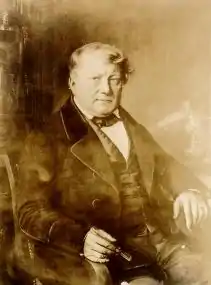
Christian Schönbein publie le principe de la pile à combustible.
- 1826 :
- - Thomas Drummond construit une source lumineuse sur le modèle proposé par Goldsworthy Gurney en 1823.
- - Samuel Brown teste son moteur à combustion interne à hydrogène en faisant gravir à un véhicule la Shooter's Hill (la plus haute colline de Londres, 132 m).
- 1834 :
- - Michael Faraday énonce les lois de l'électrolyse de Faraday[16],[17].
- - Émile Clapeyron publie Mémoire sur la puissance motrice de la chaleur (OCLC 249625532).
- 1839 - Christian Friedrich Schönbein publie le principe de la pile à combustible dans le Philosophical Magazine.
- 1842 - William Robert Grove réalise la première pile à combustible (qu'il baptise la gas voltaic battery).
- 1849 - Eugene Bourdon réalise un manomètre, le tube de Bourdon.
1850-1899
- 1863 - Etienne Lenoir construit un véhicule mu par un moteur mono-cylindre à deux temps alimenté au gaz de houille.
- 1866 - August Wilhelm von Hofmann réalise son voltamètre qui permet l'électrolyse de l'eau.
- 1873 - Thaddeus S. C. Lowe réalise un dispositif de production d'hydrogène basé sur le processus de décomposition de l'eau Lavoisier-Meusnier développé en 1784.

- 1874 - Jules Verne écrit dans son roman L'Île mystérieuse : « Oui, mes amis, je crois que l’eau sera un jour employée comme combustible, que l’hydrogène et l’oxygène, qui la constituent, utilisés isolément ou simultanément, fourniront une source de chaleur et de lumière inépuisables et d’une intensité que la houille ne saurait avoir. »[18]
- 1877 - Le Suisse Amé Pictet et le Français Louis Paul Cailletet liquéfient l'oxygène indépendamment l'un de l'autre et à la suite de ces travaux, le professeur Zygmunt Wróblewski, de l'université de Cracovie, réussit la première liquéfaction de l'hydrogène[1].
- 1884 - Charles Renard et Arthur Constantin Krebs lancent le dirigeable La France.
- 1885 - Zygmunt Florenty Wróblewski détermine le point critique de l'hydrogène à 33 K et 13,3 atmosphères et son point d'ébullition à 23 K.
- 1889 - Ludwig Mond et Carl Langer utilisent pour la première fois l'appellation « fuel cell » (pile à combustible).
- 1893 - Friedrich Wilhelm Ostwald détermine expérimentalement le rôle de chacun des composants d'une pile à combustible.
- 1896 :
- - D.D. Jackson et J. W. Ellms rapportent la production d'hydrogène par une algue microscopique l'anabaena[19].
- - Leon Teisserenc de Bort mène des expériences météorologiques dans la troposphère avec un ballon-sonde[20].
- 1897 - Paul Sabatier améliore la méthode d'hydrogénation de composés organiques par le procédé appelé réaction de Sabatier.
- 1898 - James Dewar met au point un procédé de production d'hydrogène liquide et développe un récipient isolant, le vase Dewar, afin d'étudier les gaz à basses températures.
- 1899 - James Dewar obtient pour la première fois de l'hydrogène solide.
1900-1924

Ferdinand von Zeppelin lance son premier dirigeable à hydrogène.
- 1900 - Ferdinand von Zeppelin lance son premier dirigeable à hydrogène le Zeppelin LZ1.
- 1901 - Wilhelm Normann introduit l'hydrogénation des graisses et huiles, qui produit des acides gras saturés. Si cette réaction est incomplète ou renversée des acides gras trans sont produits.
- 1903 - Constantin Tsiolkovski publie Исследование мировых пространств реактивными приборами (« L'Exploration des espaces cosmiques au moyen d'engins à réaction »)[21].
- 1907 - Installation de la première ligne civile de production d'hydrogène à Saint-Louis pour gonfler les aérostats de la coupe aéronautique Gordon Bennett.
- 1909 :
- - Ferdinand von Zeppelin réalise, en mai, le premier vol longue distance avec son Zeppelin LZ5 en parcourant 1 320 km[22].
- - Adolph Frank, Carl von Linde et Heinrich Caro développent un procédé de production d'hydrogène connu sous le nom de procédé Linde-Frank-Caro[23].
- 1910 :
- - Un premier passager embarque sur le Zeppelin LZ7.
- - Fritz Haber dépose un brevet pour un procédé chimique destiné à synthétiser de l'ammoniac (NH3) à partir du diazote (N2) gazeux atmosphérique et du dihydrogène (H2) gazeux en présence d'un catalyseur, le procédé Haber qui est perfectionné ensuite par le Français Georges Claude, fondateur de la société L’Air liquide. L’hydrogène devient une matière première de l’industrie chimique[1].
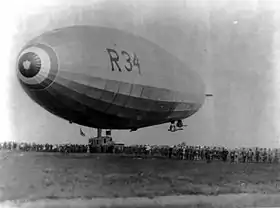
Le dirigeable britannique HMA R34 est le premier à traverser l'Atlantique.
- 1912 - Premiers vols commerciaux réguliers de passagers entre l'Allemagne, le Danemark et la Suède sur le Zeppelin LZ13.
- 1919 - Première traversée transatlantique du dirigeable britannique HMA R34.
- 1920 - Une usine d'hydrogénation du lignite utilisant le processus d'hydrocraquage est construite à Leuna en Allemagne[24].
- 1923 :
- - Reformage catalytique, le premier méthanol de synthèse est produit par BASF à Leuna.
- - John Burdon Sanderson Haldane envisage dans Daedalus; or, Science and the Future (en) de « grandes centrales électriques éoliennes qui par jour de grand vent utiliseront l'excédent d'électricité pour la décomposition électrolytique de l'eau en oxygène et hydrogène. »[25]
1925-1949
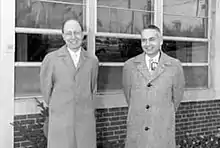
Eugene Wigner (à gauche) et Alvin Weinberg.
- 1926 :
- - F. E. Vandeveer et S. W. Parr, à l'université d'Illinois, utilisent l'oxygène plutôt que l'air pour produire du gaz de synthèse, procédé dit de l'oxydation partielle[26],[27].
- - Cyril Norman Hinshelwood étudie la réaction explosive hydrogène-oxygène et décrit le phénomène de la réaction en chaîne.
- - Umberto Nobile réalise le premier survol du pôle Nord à bord du dirigeable à hydrogène le Norge.
- 1929 - Paul Harteck et Karl Friedrich Bonhoeffer obtienne la première synthèse de parahydrogène pur.
- 1930 - Rudolf Erren développe un moteur (brevet GB364180) qui fonctionne selon un principe amélioré de la combustion du mélange hydrogène-oxygène[28],[29]
- 1935 - Eugene Wigner et Hillard Bell Huntington prédisent l'hydrogène métallique.
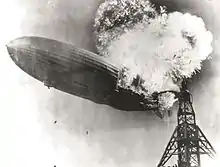
, le Hindenburg en flammes.
- 1937 :
- - Le Zeppelin LZ 129 Hindenburg est détruit par le feu lors de son arrivée à l'aéroport de Lakehurst près de New York.
- - Le Heinkel HeS 1 le premier moteur à réaction expérimental à hydrogène est testé par Hirth Motoren GmbH.
- - Le premier turbo-générateur refroidi à l'hydrogène est mis en service à Dayton dans l'Ohio[30],[31].
- 1938 :
- - Le premier hydrogénoduc, long de 240 km est mis en service dans la Ruhr en Allemagne[32].
- - Igor Sikorsky propose l'utilisation de l'hydrogène liquide comme combustible[33].
- 1939 - Hans Gaffron (en) découvre que les algues peuvent produire alternativement de l'oxygène ou de l'hydrogène[34].
- 1943 :
- - L'hydrogène liquide est testé comme carburant de moteur-fusée à la l'université d'État de l'Ohio.
- - Arne Zetterström décrit un mélange gazeux pour la plongée sous-marine très profonde, l'hydrox[35].
- 1949 - Le procédé d'hydrodésulfuration par reformage catalytique est commercialisé[36].
1950-1974
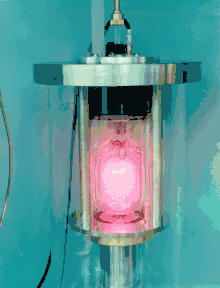
Un Maser à hydrogène.(Image NASA/JPL-Caltech)
- 1952 :
- - Le professeur Robert Dicke de l'université de Princeton conduit les premières expériences du maser à hydrogène[37]
- - La compagnie H. L. Johnston met au point un vase Dewar sans réfrigération pour le transport d'hydrogène liquide par avion[38].
- 1955 - Willard Thomas Grubb modifie la pile à combustible en utilisant une membrane d'échange ionique en polystyrène sulfonisé comme électrolyte[39].
- 1957 :
- - Le moteur à réaction Pratt & Whitney modèle 304 fonctionnant à l'hydrogène liquide est testé pour la première fois sur l'avion de reconnaissance Lockheed CL-400 Suntan (en)[40].
- - Les spécifications du semi-remorque U-2 destiné transport de l'hydrogène liquide par la route sont ennoncées[41].
- 1958 :
- - Leonard Niedrach conçoit un moyen de déposer du platine sur la membrane d'une pile à combustible dite de Grubb-Niedrach[42].
- - La société Allis-Chalmers présente le premier tracteur muni d'une pile à combustible d'une puissance de 15 kW, le modèle D 12[43].
- 1959 - Francis Thomas Bacon réalise la Bacon Cell, la première pile à combustible hydrogène-air de 5 kW pour l'alimentation d'un poste de soudure à l'arc.
- 1960 - La société Allis-Chalmers construit le premier chariot élévateur à pile à combustible[44].

Moteur-fusée à l'hydrogène liquide J-2.
- 1963 - Vol du premier moteur-fusée alimenté à l'hydrogène liquide, le RL-10[45].
- 1964 - La société Allis-Chalmers réalise une pile à combustible de 750 W afin d'alimenter un sous-marin de recherche monoplace[46].
- 1965 :
- - Le programme Gemini utilise des piles à combustible.
- - La société Allis-Chalmers construit les premières piles à combustible destinées aux voiturettes de golf.
- 1966 :
- - Recherche d'applications pour l'utilisation de l'hydrogène slush[47].
- - Premier vol du moteur-fusée à l'hydrogène liquide J-2.
- 1967 - Akira Fujishima (en) découvre l'effet Honda-Fujishima (propriétés photocatalytiques du dioxyde de titane) qui est utilisé pour l'hydrolyse dans les cellules photoélectrochimiques.
- 1970 :
- - La Communications Satellite Corporation développe la batterie nickel hydrogène[48].
- - John Bockris (en) ou Lawrence W. Jones (en) utilise pour la première fois l'expression « économie hydrogène »[49],[50]
- 1973 - La société Air liquide met en service un hydrogénoduc de 30 km à Isbergues dans le Pas-de-Calais.
1975-1999

La navette spatiale américaine, dont le moteur principal fonctionne à l'oxygène et hydrogène liquides.
- 1975 - John Bockris (en) publie Energy, The Solar-Hydrogen Alternative (Énergie, l'alternative hydro-solaire)[51].
- 1979 - La Snecma met en service le moteur-fusée HM-7, à oxygène et hydrogène liquides, pour propulser le 3e étage de la fusée Ariane 1.
- 1981 - Premier vol de la navette spatiale américaine grâce à son moteur principal à oxygène et hydrogène liquides.
- 1990 - Mise en service de la Solar-Wasserstoff-Bayern (centrale de production d'hydrogène par énergie solaire de Bavière)[52].
- 1996 - Le premier vol du moteur Vulcain qui équipe le lanceur Ariane 5.
- 1997 - Anastasios Melis (en) découvre qu'une carence en soufre conduit les algues à produire de l'hydrogène, plutôt que de l'oxygène. Il détermine que des enzymes, les hydrogénases sont responsables de cette production[53].
- 1998 - Lancement du sous-marin Unterseeboot type 212 dont le système de propulsion anaérobie utilise des piles à combustible à membrane électrolyte polymère.
XXIe siècle
- 2000 - Peter Toennies (en) démontre la superfluidité de l'hydrogène à la température de 0,15 K.
- 2002 - Lancement du sous-marin Type 214 dont le système de propulsion anaérobie utilise des piles à combustible à membrane électrolyte polymère.
- 2004 - Projet allemand DeepC (en) d'un véhicule sous-marin autonome propulsé par un moteur électrique alimenté par une pile à combustible à hydrogène[54].
- 2005 - Compresseur ionique
- 2010 - Une Aston Martin Rapide S équipée d'un moteur à combustion interne, technologie hybride à hydrogène mise au point par Alset, participe aux 24 Heures de Nürburgring en Allemagne.
- 2013 - Premier système industriel couplant production par électrolyse et stockage d'hydrogène solide (par McPhy Energy)[55]
- 2015 - Découverte en France d'un vecteur d'hydrogène liquide a base de polysiloxanes.
- 2018, en Allemagne, deux prototypes de trains Alstom Ilint à hydrogène entrent en service commercial dans la région de Buxtehude – Bremervörde – Bremerhaven – Cuxhaven.
- 2020, en France, de l'hydrogène métallique moléculaire (instable) est créé en laboratoire, en quantité infime.
Notes et références
- Historique de l'hydrogène sur le site de association française de l'hydrogène
- Andreas Züttel 2008, p. 7.
- August Buck, Sciences de la Renaissance, Vrin, 1973. (ISBN 9782711606801), p. 265.
- Nicolas Lémery, Cours de chymie: Contenant la maniere de faire les operations qui sont en usage dans la medecine, par une methode facile. … Paris : Jean-Baptiste Delespine, 1701. (OCLC 79953810)
- 1784 Experiments
- Hydrogen production for ballooning during the French Revolution: An early example of chemical process development, DOI:10.1080/00033798300200381
- (en) Margaret Jacob et Wijnand W Mijnhardt, The Dutch Republic in the eighteenth century : decline, Enlightenment, and revolution, Ithaca, Cornell University Press, , 365 p. (ISBN 978-0-8014-8050-8, OCLC 859580998), p. 314
- Henri Michelet, L'inventeur Isaac de Rivaz (1752-1828), Martigny : Pillet 1965. (OCLC 163739058), p. 226.
- (en) Fleming, 1809 History of Meteorology 25 p. 25
- Martin Brenner, 1809 Pilot Balloon History
- Edward Daniel Clarke, The gas blow-pipe, or Art of fusion by burning the gaseous constituents of water: giving the history of the philosophical apparatus so denominated; the proofs of analogy in its operations to the nature of volcanoes; …, Londres, Ptd. for T. Cadell and W. Davies by R. Watts, 1819. (OCLC 228678190)
- David Brewster et Royal Society of Edinburgh, The Edinburgh philosophical journal, Printed for Archibald Constable, 1822. vol. 7, p. 364.
- 1820 Cecil engine, université de Cambridge
- 1820 Cecil the letter, université de Cambridge
- Ingo Müller et Peter Strehlow, Rubber and rubber balloons: paradigms of thermodynamics, Springer, 2004. (ISBN 9783540202448), p. 112
- Carole H MacQuarrie, Donald Mcquarrie, Peter A Rock et C. Jung, Chimie générale, De Boeck Université, 2000. (ISBN 9782804137038), p. 834
- (en) Samuel Glasstone, An introduction to electrochemistry, Place of publication not identified, Maurice Press, , 557 p. (ISBN 978-1-4437-2294-0, OCLC 314129713, lire en ligne), p. 15
- L’Île mystérieuse - Partie 2, Chapitre 11
- Oskar R. Zaborsky et John R. Benemann, Biohydrogen, Springer, 1998. (ISBN 9780306460579), p. 20
- (en) 1896 Weather balloon, Met Office
- Philippe Bailhache et Nikolaf Pavlovich Barabashov, Constantine-E. Tsiolkovski, précurseurs des vaisseaux interplanétaires … Paris : Éditions du Pont Royal, 1961 (OCLC 2512128), p. 19.
- Roger Parkinson, The encyclopedia of modern war, Taylor & Francis, 1977. (ISBN 9780812818987), p. 4.
- La Revue scientifique, 1911, p. 694.
- Jean Tournier, Les mots anglais du français, Belin, 1998. (ISBN 9782701123042), « hydrocraquage »
- John B. S. Haldane, Daedalus or science and the future. London : Paul, 1924. (OCLC 315153359)
- Frank G. Kerry, Industrial gas handbook: gas separation and purification, CRC Press, 2007. (ISBN 9780849390050), p. 230 et 270.
- Klaus Weissermel et Hans-Jürgen Arpe, Chimie organique industrielle, De Boeck Université, 2000. (ISBN 9782744500732)
- Peter Hoffmann 2002, p. 31.
- (en) Improvements in and relating to internal combustion engines using a mixture of hydrogen and oxygen as fuel
- Electrical World, The electrical power industry, past, present and future, McGraw-Hill, 1949. (OCLC 23480123), p. 40
- Joseph Nathan Kane, Famous first facts: a record of first happenings, discoveries and inventions in the United States, H. W. Wilson, 1964. (OCLC 369382), p. 228.
- (en) The Technological Steps of Hydrogen Introduction, p. 24
- Peter Hoffmann 2002, p. 32.
- « Hydrogen metabolism of green algae: discovery and early research a tribute to Hans Gaffron » in Govindjee, John F. Allen, J Thomas Beatty et Howard Gest, Discoveries in Photosynthesis Springer, 2006. (ISBN 9781402033230), p. 119-129
- Anders Lindén, Anders Muren et Arne Zetterström, Arne Zetterström and the First Hydrox Dives, Swedish National Defence Research Institute, 1985. (OCLC 16126117)
- William Arthur Gruse et Donald Raymond Stevens, Chemical technology of petroleum, McGraw-Hill, 1960. (OCLC 888134), p. 307.
- Joan Lisa Bromberg, The laser in America, 1950-1970, MIT Press, 1991. (ISBN 9780262023184), p. 28
- Mobile Liquid Hydrogen Equipment, 1952-1954, NASA
- L. O. Vasquez, Fuel Cell Research Trends, Nova Publishers, 2008. (ISBN 9781600216695), p. 10
- John L. Sloop, Liquid hydrogen as a propulsion fuel, 1945-1959.(The NASA history series) (NASA SP-4404), National Aeronautics and Space Administration, , 154–157 p. (lire en ligne)
- NASA-Liquid Hydrogen as a Propulsion Fuel, 1945-1959
- Académie nationale des sciences, Applied science and technological progress; Washington, U. S. Govt. Print. Off. 1967. (OCLC ), p. 336
- (en) George Wand, Fuel Cell History, Part 2, p. 7.
- (en) 1960 - Fleet module Pag.3
- (en) « Renowned Rocket Engine Celebrates 40 Years of Flight », Pratt & Whitney,
- (en) 1964 Allis Chalmers Pag.1
- International Institute of Refrigeration, Pure and Applied Cryogenics, Pergamon Press, 1966. vol. 6, p. 489.
- (en) Nickel-Hydrogen Battery Technology—Development and Status
- (en) History of Hydrogen
- Lawrence W. Jones (en) Toward a liquid hydrogen fuel economy, University of Michigan Engineering Technical Report UMR2320, 13 mars 1970
- (en) John O'Mara Bockris, Energy, the solar hydrogen alternative, New York, Wiley, , 365 p. (ISBN 978-0-470-08429-8, OCLC 635657708)
- C.-J. Winter et M. Fuchs, « Hysolar and Solar-Wasserstoff-Bayern » in International journal of hydrogen energy, 1991, vol. 16, no11, p. 723-734. ISSN 0360-3199.
- University of California, « Hydrogen A Renewable Fuel for a New Millennium » in University of California Report for the Department of Energy, Winter 2000. p. 4-5
- DeepC (2004), TÜV SÜD Industrie Service Gmbh
- « McPhy Energy dévoile le tout premier système industriel couplant production par électrolyse et stockage d’hydrogène solide », sur mcphy.com, (consulté le ).
Bibliographie
- Peter Hoffmann, Tomorrow's Energy : Hydrogen, Fuel Cells, and the Prospects for a Cleaner Planet, MIT Press, , 289 p. (ISBN 978-0-262-58221-6, lire en ligne)
- Andreas Züttel, Hydrogen as a future energy carrier, Wiley-VCH, (ISBN 978-3-527-30817-0, lire en ligne)
- Lynn K. Mytelka, Making Choices about Hydrogen : Transport Issues for Developing Countries, IDRC, , 379 p. (ISBN 978-92-808-1155-1, lire en ligne)
- Portail de la chimie
- Portail des technologies
- Portail de l’histoire
Cet article est issu de Wikipedia. Le texte est sous licence Creative Commons - Attribution - Partage dans les Mêmes. Des conditions supplémentaires peuvent s'appliquer aux fichiers multimédias.
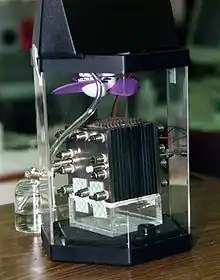
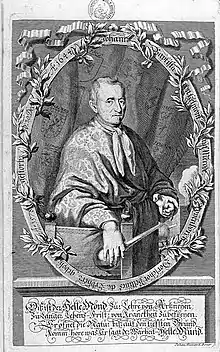
RENEW.jpg.webp)